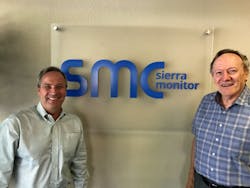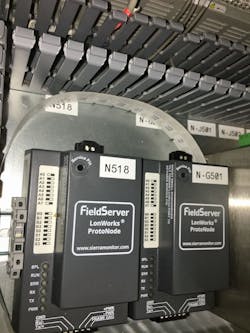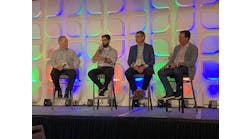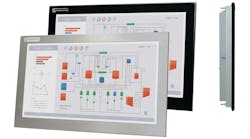Jeff Brown is Sierra Monitor’s new CEO, and he looks to grow the company’s emerging IIoT business. "You can do just about anything you want to do, but the question is what is most beneficial to you as an OEM," says Brown, who will be heading up a company celebrating 40 years of business in the Silicon Valley.
Brown has been working with Chairman Gordon R. Arnold, a founding member of the company in 1978. While Arnold is retiring, he'll stay on as chairman while he rides off into sunset of Texas. There is a lot work Arnold and Sierra Monitor have done in the past that is very relevant now, especially in the Industrial Internet of Things (IIoT) space. He also has some insight on how OEMs are starting to look to cloud and analytics going forward (Figure 1).
Figure 1: The new CEO Jeff Brown (left) at Sierra Monitor has been working closely with Chairman Gordon R. Arnold, who is retired in June 2018.
(Source: Sierra Monitor)
Sierra Monitor sells a line of industrial gas/flame detectors as well as the FieldServer family of protocol gateways and routers. It's the FieldServer products that comprise its IIoT system, connecting OEM equipment to local building management systems, as well as passing data to the cloud (Figure 2). Many OEMs are using the cloud to handle monitoring and notification, and the data visualization is provided through dashboarding and is the first step toward more advanced analytics/ software quality assurance programs.
Figure 2: FieldServer products are connecting OEM equipment to local building management systems as well as passing data to the cloud.
(Source: Sierra Monitor)
Plumb in the data
The data has been collected for years, but now it is easier to get your hands on it. "We have actually been generating lots of data for many years, both in gas-detection products we call, ‘Protect,’ and gateways we call, ‘Connect,’" says Arnold. "Most users in the control world don't use a large amount of that data because they never had access to it—not the way they can have it in IIoT. Now, it's a natural for us to deliver it as IoT data and then help them to find the critical pieces to fine tune what they are doing as an OEM, an end user or anywhere in between."
It's an interesting company, says Brown. "What intrigued me about Sierra Monitor is Gordon (Arnold) and the team have been building the most complete and one of the best protocol conversion gateway products in the world," he says. "It's been sitting there for years with tens of thousands of units out there doing its job generating this data, and now we have the ability to bring it into the cloud, analytics and data visualization."
And more intelligence can be put in the end unit to be able to do edge computing type things, continues Brown. "It's a really fun place to be—you are at the creation of the data," he says. "Very few companies can get to the plumbing area of the data where we can source that data."
A significant amount of information is available for use within a product or controller. However, engineers often have little ability to compare what's going on inside a machine with another machine. With Sierra Monitor's protocol conversion, they don't write partial code—it doesn't look at one parameter—it looks at all parameters and moves them through.
It's big data in the sky
"We knew we’re handling valuable data that, in the past, only one machine could take advantage of," says Arnold. "The last few years we have been developing the ability to collectively or selectively put the data in a cloud base where the customer could then start analyzing it to determine what's going well, where they should send the service man or fine tune the OEM equipment based on a much bigger sample of data."
Sierra Monitor has its own cloud that runs on Amazon Web Services (AWS) and also works with other third parties as some OEMs have their own cloud solutions (Figure 3). "It's all about the analytics and the things going on now, where we can take that data and actually provide something that those OEMs can act on," says Brown. "The OEMs are really starting to embrace the concept and are asking, ‘How fast can you get us this information?’ It helps them to get ahead of the curve with their customers when they can take a deep dive into these datasets."
Figure 3: Sierra Monitor works with other third parties as some OEMs have their own cloud solutions.
(Source: Sierra Monitor)
What's interesting is that some of the least technologically advanced systems are all of a sudden really zooming into the latest and greatest in terms of capabilities, says Brown. A good example is boiler/hot-water industry, he says. "In the past they may know if the boiler is on or not. But there are all kinds of things they want to know about it—cycle counts, ignition sequence—things that help them fine tune the operation and possibly extend the life of it for their customers. Whether it’s an older boiler or a new boiler, it doesn't matter; we can collect data as long as it has a protocol that we can pull from and gateway the information out."
Does data cost money?
"Sierra Monitor is not the people who select the data to be collected," says Arnold. "The people who know their product determine what they want to see. For OEMs, we can read it with our IIoT gateways. The data can then be stored in the cloud, and, even before analytics are used, there are dashboards. Dashboards are provided for the customers to look at with a smartphone app or on the computer to visualize the data. They can also take the data off the cloud and use it in whatever analytics they want, and we are and will continue to build analytic capabilities into our cloud."
A very important lesson is to think about who has the expense and who has the benefit of this process—an OEM or a customer, says Arnold. "If an OEM thinks in terms of: ‘This is a benefit to my customer,’ then the OEM may be unwilling to pay for the cloud side,” he says. "If the OEM sees it as a great benefit, maybe it is willing to pay for it. We have figured out the challenges in selling the capability, and we now know how to sell it to avoid the pitfall of who pays for it. OEMs need to understand the ability of the system, and then they can decide how they want to pursue it."
Understanding is key, or it needs to be simple because, without the right hardware and software, it's not easy to work with the data. "We went into it with a preconceived notion that, if we delivered data, the customer knew what to do with it," says Arnold. "When you think in the terms of big databases, such as Oracle and SAP, that's an assumption going in to designing a system. But we really found that the customers didn't know what to do with the data, didn't have the technical skills to develop their own dashboard or even their own data handling. We needed to tack on those capabilities, so the customer could get to visualization quickly and only then start working towards the analytics side."
Just like the cost of PCs decreasing while the capabilities are increasing, the same is occurring in the cloud, says Brown. "We have gotten to a cost point where a new customer is putting small gateway devices on residential water heaters," he says. "Connecting to the heaters enables them to be serviced more effectively."
You must have data
"Right now, a manufacturer of a controller has almost no ability to change the capability of the control once it is in the field," says Arnold. "Remote downloads are possible, but by computing in our connect box and in the cloud, going forward, we will be able to utilize the data to make smart control changes in the devices in the field. For example, the data may show that running motors at 25% duty cycle causes many more failures than at 30% duty cycle. That data, available from the cloud, could feed an algorithm to run the motor at a more optimum rate. Edge computing is going to happen because of the cloud capabilities."
OEMs don’t realize how valuable the data is yet, says Arnold. "Therefore, the OEM decision makers may not be ready to spend the money on data, cloud and analytic capabilities," he says. "However, they will be begging for it in a few years. I have been in the gas-detection business for 40 years. There have been numerous times where I have regretted not being able to see the data from multiple units in the field to understand something that is going on. In some cases, sensors were misbehaving, and, if we knew what lot they came from or what the process was, what the date of manufacture was and how they were misbehaving, we could have nailed down a solution in weeks, but instead it took a year.”
People will be seeing the value of the data, understanding the need of data, and they will want it. While receiving a weekly email from Cadillac showing the number of panic stops may not be valuable, because you are just hotrodding around, a text message stating that your hybrid car is fully charged, is useful. While the OEM may still be trying to figure out what data is important, it is still being stored in the cloud so it will be available when needed.









